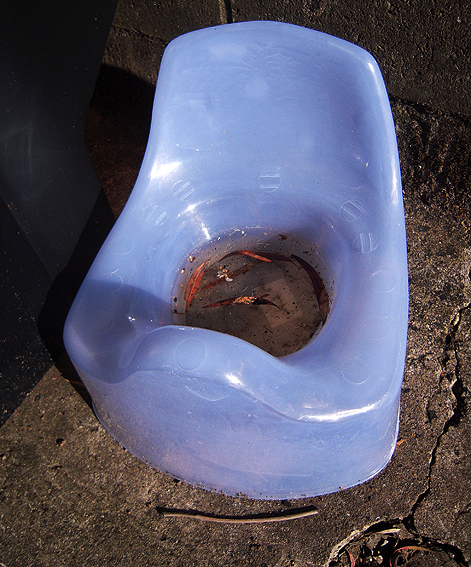A rare find, the abandoned potty – which begs the question, what does happen to all the old potties? Does everybody keep them, clinging to their first shit receptacle alongside Teddy and blankie, a memento of simpler, more innocent days? Perhaps they all go to landfill, helping to fill those big holes in the earth with empty poo containers.
Few discards are so richly imbued with symbolism. The potty is all about training to let it go, the first step on a lifetime journey of banishing our waste products out of sight and (hopefully!) out of mind, to lie like guilty things in the deep, dark subterranean tunnels of our psyche – I mean, sewers. Sewers. I definitely meant sewers.
The back lane death is the antithesis of this learnt behaviour. For a start, it is public – everybody can see what you have dumped by the roadside. True, it is often done anonymously but the consequence is that the deposit is there for everybody to see and step over, and for somebody else to clean up. The potty is all about learning to become a social being, whereas dumping is basically anti-social, however much we might kid ourselves that it is all part of the ‘sharing’ economy.
Or maybe people simply see the laneway as a gigantic potty, connected to them but not a part of them, something beyond the back side of their homes. After all, we are taught to get rid of our waste by-products, not to hold onto them regardless, so it should come as no surprise that ridding ourselves of something unwanted or broken can engender a cathartic sense of release, an unburdening, that is deep-rooted. And it all starts with the potty.
At the same time, the potty is one of the most intense dumps anyone might wish to stumble across (or not, as the case may be). It’s like finding a spent nuclear fuel rod or blood-filled syringe – unclean, unclean, get it away from me. No-one is going to touch these things.
Although when you think about it – which, strangely enough, I do – there is nothing intrinsically more or less dirty about these potties compared to any other item left lying in the open, a cooler or a stacking chair for instance. It is merely plastic moulded into a particular shape, not unlike a dog’s bowl. Given what they are though, their function and the associations that cling to them, I doubt many people would be prepared to take them home.
They are too intimate, too close to a public taboo, too redolent of our own bodily processes and those of other – presumably now grown-up – humans.
The abandoned potty is as poignant as the empty doll pram or the driver-less ride-on toy; the seat, so to speak, of our anxieties and regrets about growing up, that gradual, daily accumulation of guilt and shame as if we, not the potties, are the empty receptacles waiting to be filled with all that is toxic and dirty.
